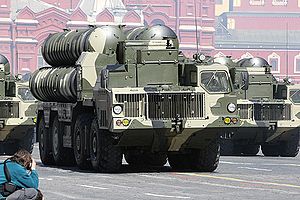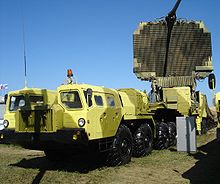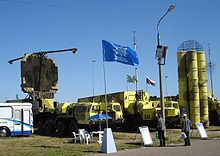Ballistic-Missile Defence (BMD)
S-300PMU-2
India has bought six S-300 batteries in August 1995 for $1 billion, probably the S-300PMU-2 version, believed to consist of 48 missiles per system. These will most likely be used in the short-range ballistic-missile defence (BMD) role against Pakistan's M-11 missiles.
| S-300PMU-2NATO reporting name: SA-10 Grumble, SA-12 Giant/Gladiator, SA-20 Gargoyle | |
|---|---|
 S-300 anti-aircraft missile system at the Victory Parade, Red Square, 9 May 2009. | |
| Type | long-range strategic SAM system |
| Place of origin | |
| Service history | |
| In service | 1978-present |
| Production history | |
| Designer | Almaz-Antey:
|
| Designed | 1997 |
| Manufacturer | MZiK Samsung Group |
| Produced | 1997-present |
The S-300 is a series of Russian long range surface-to-air missile systems produced by NPO Almaz, all based on the initial S-300P version. The S-300 system was developed to defend against aircraft and cruise missiles for the Soviet Air Defence Forces. Subsequent variations were developed to intercept ballistic missiles. The S-300 was jointly produced by Almaz with Samsung Group of South Korea since 1993.
The S-300 system was first deployed by the Soviet Union in 1979, designed for the air defense of large industrial and administrative facilities, military bases, and control of airspace against enemy strike aircraft.
The project-managing developer of the S-300 is Russian Almaz corporation (government owned, aka "KB-1") which is currently a part of "Almaz-Antei" Air Defense Concern. S-300 uses missiles developed by MKB "Fakel" design bureau (a separate government corporation, aka "OKB-2").
The S-300 is regarded as one of the most potent anti-aircraft missile systems currently fielded . Its radars have the ability to simultaneously track up to 100 targets while engaging up to 12. S-300 deployment time is five minutes. The S-300 missiles are sealed rounds and require no maintenance over their lifetime. An evolved version of the S-300 system is the S-400 (NATO reporting name SA-21), entering service in 2004.
S-300PMU-1/2 (SA-20)
The S-300PMU-1 (Russian С-300ПМУ-1,US DoD designation SA-20A, NATO reporting name SA-20 GARGOYLE) was also introduced in 1992 with the new and larger 48N6 missiles for the first time in a land-based system and introduced all the same performance improvements from the S300FM version including the increased speed, range, TVM guidance and ABM capability. The warhead is slightly smaller than the naval version at 143 kg (315 lb). This version also saw the introduction of the new and more capable 30N6E TOMB STONE radar.
The S-300PMU-1 was introduced in 1999 and for the first time introduces several different kinds of missiles in a single system. In addition to the 5V55R, 48N6E and 48N6E2 missiles the S-300PMU-1 can utilise two new missiles, the 9M96E1 and 9M96E2. Both are significantly smaller than the previous missiles at 330 and 420 kg (728 and 926 lb respectively) and carry smaller 24 kg (53 lb) warhead. The 9M96E1 has an engagement range of 1–40 km (1-25 mi) and the 9M96E2 of 1–120 km (1-75 mi). They are still carried 4 per TEL. Rather than just relying on aerodynamic fins for manoeuvring, they use a gas-dynamic system which allows them to have an excellent probability of kill (Pk) despite the much smaller warhead. The Pk is estimated at 0.7 against a tactical ballistic missile for either missile. The S-300PMU-1 typically uses the 83M6E command and control system, although it is also compatible with the older Baikal-1E and Senezh-M1E CCS command and control systems. The 83M6E system incorporates the 64N6E (BIG BIRD) surveillance/detection radar. The fire control/illumination and guidance radar used is the 30N6E(1), optionally matched with a 76N6 low altitude detection radar and a 96L6E all altitude detection radar. The 83M6E command and control system can control up to 12 TELs, both the self propelled 5P85SE vehicle and the 5P85TE towed launchers. Generally support vehicles are also included, such as the 40V6M tow vehicle, intended for lifting of the antenna post.
The S-300PMU-2 Favorite (Russian С-300ПМУ-2 Фаворит – Favourite, DoD designation SA-20B), introduced in 1997, is an upgrade to the S-300PMU-1 with range extended once again to 195 km (121 mi) with the introduction of the 48N6E2 missile. This system is apparently capable against not just short range ballistic missiles, but now also medium range tactical ballistic missiles. It uses the 83M6E2 command and control system, consisting of the 54K6E2 command post vehicle and the 64N6E2 surveillance/detection radar. It employs the 30N6E2 fire control/illumination and guidance radar. Like the S-300PMU-1, 12 TELs can be controlled, with any mix of 5P85SE2 self propelled and 5P85TE2 trailer launchers. Optionally it can make use of the 96L6E all altitude detection radar and 76N6 low altitude detection radar, just like the S-300PMU-1.



No comments:
Post a Comment